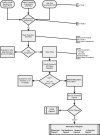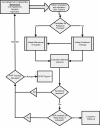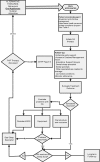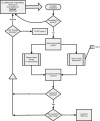Clinical guideline for the evaluation, management and long-term care of obstructive sleep apnea in adults
- PMID: 19960649
- PMCID: PMC2699173
Clinical guideline for the evaluation, management and long-term care of obstructive sleep apnea in adults
Abstract
Background: Obstructive sleep apnea (OSA) is a common chronic disorder that often requires lifelong care. Available practice parameters provide evidence-based recommendations for addressing aspects of care.
Objective: This guideline is designed to assist primary care providers as well as sleep medicine specialists, surgeons, and dentists who care for patients with OSA by providing a comprehensive strategy for the evaluation, management and long-term care of adult patients with OSA.
Methods: The Adult OSA Task Force of the American Academy of Sleep Medicine (AASM) was assembled to produce a clinical guideline from a review of existing practice parameters and available literature. All existing evidence-based AASM practice parameters relevant to the evaluation and management of OSA in adults were incorporated into this guideline. For areas not covered by the practice parameters, the task force performed a literature review and made consensus recommendations using a modified nominal group technique.
Recommendations: Questions regarding OSA should be incorporated into routine health evaluations. Suspicion of OSA should trigger a comprehensive sleep evaluation. The diagnostic strategy includes a sleep-oriented history and physical examination, objective testing, and education of the patient. The presence or absence and severity of OSA must be determined before initiating treatment in order to identify those patients at risk of developing the complications of sleep apnea, guide selection of appropriate treatment, and to provide a baseline to establish the effectiveness of subsequent treatment. Once the diagnosis is established, the patient should be included in deciding an appropriate treatment strategy that may include positive airway pressure devices, oral appliances, behavioral treatments, surgery, and/or adjunctive treatments. OSA should be approached as a chronic disease requiring long-term, multidisciplinary management. For each treatment option, appropriate outcome measures and long-term follow-up are described.
Figures






References
-
- American Academy of Sleep Medicine. Diagnostic and coding manual. 2nd Edition. Westchester, IL: American Academy of Sleep Medicine; 2005. International classification of sleep disorders.
-
- Delbecq A, vande Ven A. A group process model for problem identification and programme planning. J Appl Behav Sci. 1971;7:467–92.
-
- Kushida CA, Morgenthaler TI, Littner MR, et al. Practice parameters for the treatment of snoring and Obstructive Sleep Apnea with oral appliances: an update for 2005. Sleep. 2006;29:240–3. - PubMed
-
- Johns MW. A new method for measuring daytime sleepiness: the Epworth sleepiness scale. Sleep. 1991;14:540–5. - PubMed
Publication types
MeSH terms
Grants and funding
LinkOut - more resources
Full Text Sources
Other Literature Sources
Medical
